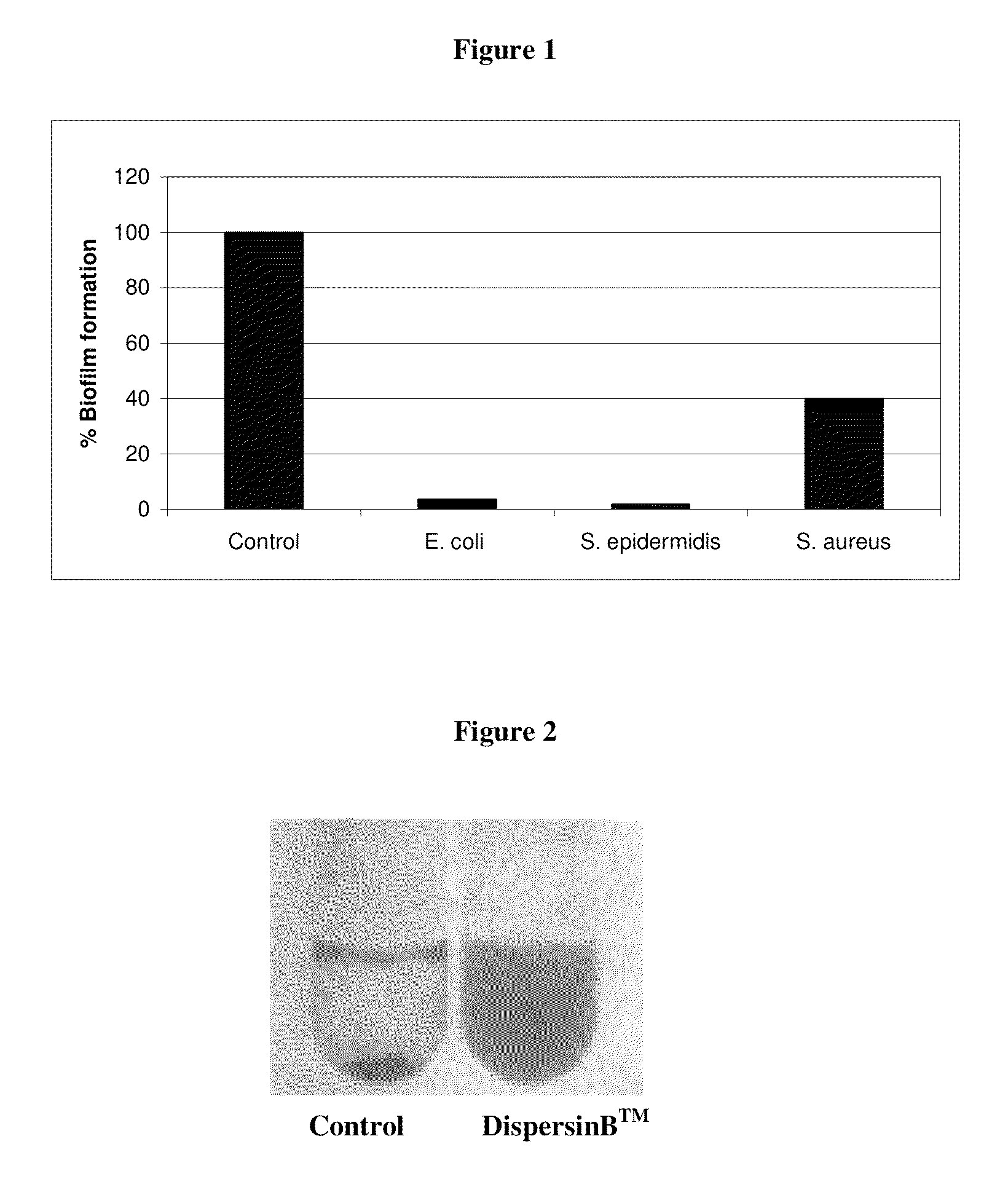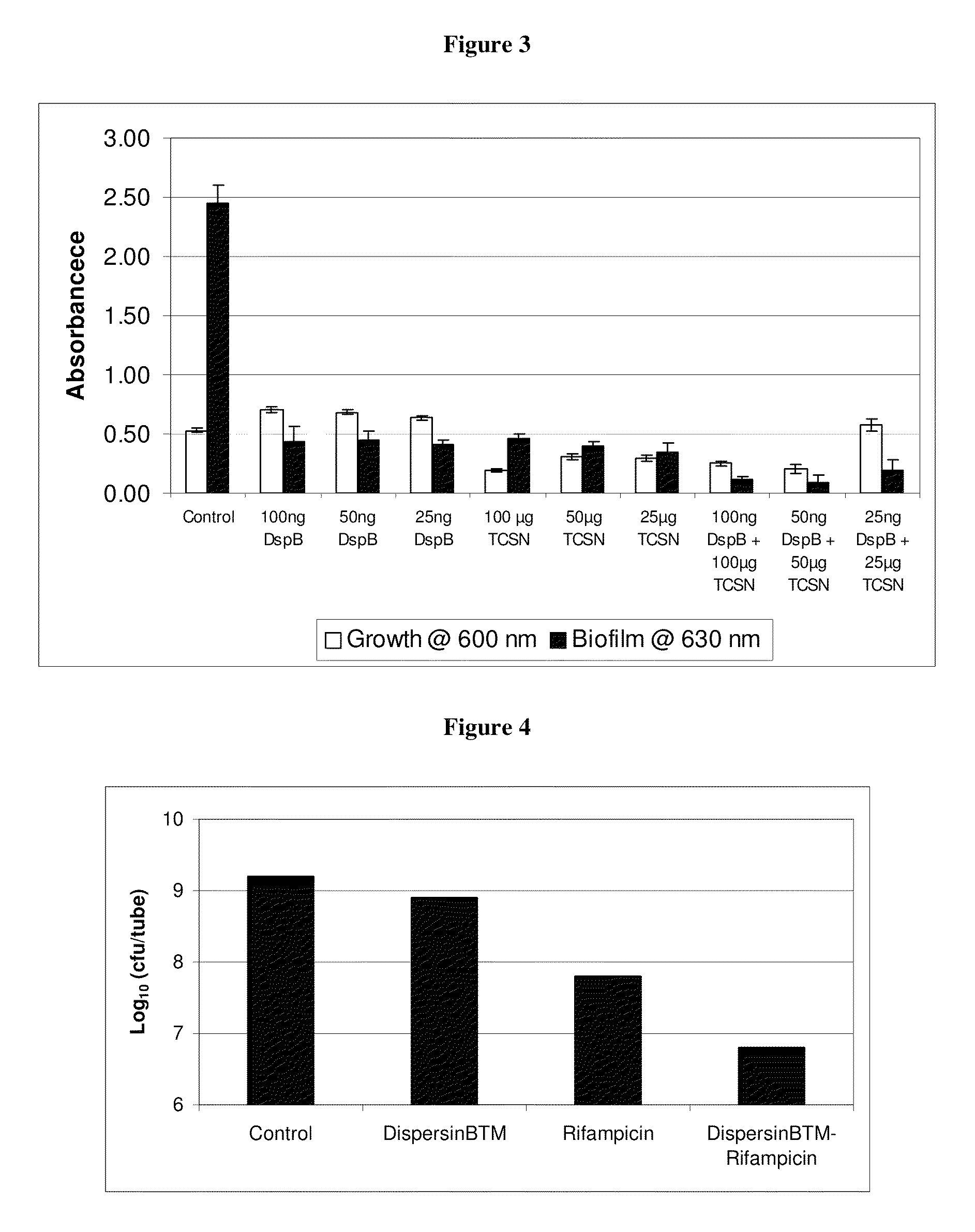Soluble .beta.-N-acetylglucosaminidase based antibiofilm compositions and uses thereof
a technology of acetylglucosaminidase and soluble beta nacetylglucosaminidase, which is applied in the direction of antibacterial agents, peptide/protein ingredients, enzymology, etc., can solve the problems of increasing the cost of treatment, increasing the risk of infection of wounds, and increasing the burden on general wound management practices, so as to inhibit the proliferation
- Summary
- Abstract
- Description
- Claims
- Application Information
AI Technical Summary
Benefits of technology
Problems solved by technology
Method used
Image
Examples
example 1
Effect of DispersinB™ on Biofilm Formation
[0221]An in vitro microplate assay was performed to determine the effect of DispersinB™ on the growth and biofilm formation of E. coli, S. epidermidis, and S. aureus. E. coli biofilm was grown in colony forming antigen (CFA) medium. Purified DispersinB™ was obtained from Jeffrey Kaplan (University of Medicine and Dentistry of New Jersey) and was produced as described in Kaplan et al., 2003, J. Bacteriol. 185: 4693-4698. S. epidermidis and S. aureus biofilm was grown in tryptic soy broth (TSB). Bacteria were separately grown in 96-well microtiterplate in the absence and presence of DispersinB™ at different concentrations. The E. coli plate was incubated at 26° C. for 24 hours. The S. epidermidis and S. aureus biofilm plates were incubated at 37° C. for 24 hours. Growth of planktonic cells based on the absorbance at 600 nm was determined using Labsystems Multiskan Ascent microplate reader. Biofilm was measured by discarding the medium; rinsing...
example 2
Dispersal of S. epidermidis Biofilm by DispersinB™
[0222]Dispersal of S. epidermidis biofilm by DispersinB™ was demonstrated by growing S. epidermidis biofilm in a tube. The biofilm growth from the surface was scraped from the bottom of the tube and transferred to another tube (FIG. 2). Under these condition cells formed a sticky aggregate that rapidly settle to the bottom of the tube. Treatment of the cell aggregates with DispersinB™ resulted in uniformly turbid cell suspensions indicating that the treatment with DispersinB™ detaches the biofilm.
example 3
Enhanced Inhibitory Effect of DispersinB™ and Triclosan (TCSN) Combination on Staphylococcus epidermidis Biofilm
[0223]An in vitro microplate assay was performed to determine the effect of DispersinB™ and triclosan (an antimicrobial agent) on the growth and biofilm formation of S. epidermidis. An overnight culture of S. epidermidis in Tryptic Soy Broth (TSB) was used as inoculum. Bacteria were grown in TSB on a 96-well microtiterplate in the absence and presence of each compound (DispersinB™ or TCSN) at different concentrations separately and together (DispersinB™+TCSN). Concentrations of DispersinB™ included 25 ng / ml, 50 ng / ml, and 100 ng / ml. Concentrations of TCSN included 25 μg / ml, 50 μg / ml, and 100 μg / ml. The plate was incubated at 37° C. for 24 hours. The growth and biofilm was measured as explained in Example 1. The combination of DispersinB™ and TCSN (50 ng / ml+50 μg / ml, respectively) showed enhanced inhibitory effect on S. epidermidis biofilm formation (FIG. 3).
PUM
| Property | Measurement | Unit |
|---|---|---|
| concentration | aaaaa | aaaaa |
| concentration | aaaaa | aaaaa |
| concentration | aaaaa | aaaaa |
Abstract
Description
Claims
Application Information
 Login to View More
Login to View More - R&D
- Intellectual Property
- Life Sciences
- Materials
- Tech Scout
- Unparalleled Data Quality
- Higher Quality Content
- 60% Fewer Hallucinations
Browse by: Latest US Patents, China's latest patents, Technical Efficacy Thesaurus, Application Domain, Technology Topic, Popular Technical Reports.
© 2025 PatSnap. All rights reserved.Legal|Privacy policy|Modern Slavery Act Transparency Statement|Sitemap|About US| Contact US: help@patsnap.com



